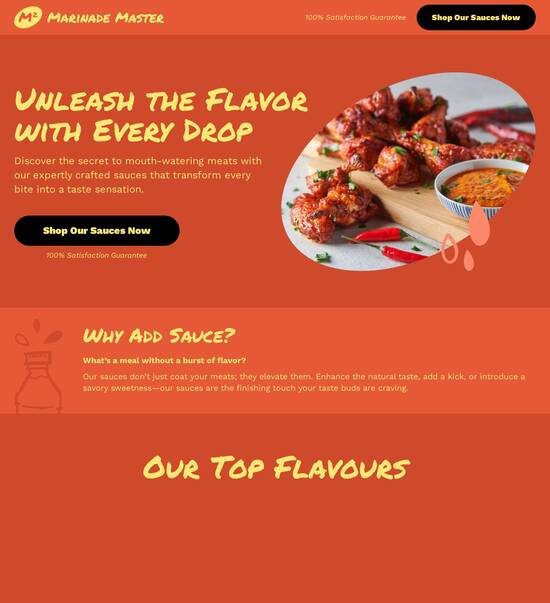
HTML page template for graphic novel publishers
Use TemplateAbout template
Engage your audience like never before with stunning landing page templates for graphic novel publishers. Make your online presence unforgettable!
Recommended templates

Easy to build without coding
With the intuitive drag-and-drop builder, anyone on your team can create high-converting pages without any knowledge of code or design. Make enhancements to your landing page with custom widgets using Javascript, HTML/CSS, or third-party scripts.

Multiple layouts for any industry and goal
Select from 500+ landing page layouts built to boost conversions across industry-specific scenarios. Customize them by adjusting fonts, adding images, and generating on-brand content with the AI assistant. Quickly scale with Instablocks® and Global Blocks that you can save, reuse, and update globally.

Loads fast and looks polished on any device
Every template is responsive, which means they present professionally on any device and load blazingly fast with our Thor Render Engine. You can also power them up with Google AMP technology to deliver an unparalleled mobile experience and drive higher conversions.

Robust analytics & experimentation
Get real-time updates and reporting across all your devices, showing the number of visitors, conversions, cost-per-visitor, and cost-per-lead. Launch AI-powered experiments, run A/B tests, and use heatmaps to analyze user behavior, then optimize your landing page to maximize conversions.







Easy to build without coding
With the intuitive drag-and-drop builder, anyone on your team can create high-converting pages without any knowledge of code or design. Make enhancements to your landing page with custom widgets using Javascript, HTML/CSS, or third-party scripts.
Multiple layouts for any industry and goal
Select from 500+ landing page layouts built to boost conversions across industry-specific scenarios. Customize them by adjusting fonts, adding images, and generating on-brand content with the AI assistant. Quickly scale with Instablocks® and Global Blocks that you can save, reuse, and update globally.
Loads fast and looks polished on any device
Every template is responsive, which means they present professionally on any device and load blazingly fast with our Thor Render Engine.
Robust analytics & experimentation
Get real-time updates and reporting across all your devices, showing the number of visitors, conversions, cost-per-visitor, and cost-per-lead. Launch AI-powered experiments, run A/B tests, and use heatmaps to analyze user behavior, then optimize your landing page to maximize conversions.
All the features you need to build lead-generating landing pages
Explore more featuresLearn how to build top-performing landing pages for any goal
FAQs
Leading the way in building high-performing landing pages





A comprehensive guide to landing page design with Instapage
To maximize the effectiveness of your online marketing strategies, Instapage's landing page features are unparalleled. This guide explores how Instapage enhances conversion rate optimization (CRO) for marketers in various sectors like business services, tech, and education.
Understanding the essentials of landing page design
Creating an effective landing page revolves around key principles that enhance user engagement and conversion rates. Instapage simplifies this process through a plethora of high-converting templates and user-friendly customization tools available at your fingertips.
- High-converting templates: Choose from over 100 pre-built templates tailored for different industries to kickstart your campaign more efficiently.
- Intuitive design elements: With pre-built lead generation tools, marketers can easily add elements that engage visitors right from the start.
- Mobile optimization: Ensure all pages function seamlessly on mobile devices, enhancing the user experience and accessibility.
Step 1: Building your landing page
The first step in creating a landing page with Instapage is selecting a template. Here’s how to get started:
- Choose a template: Navigate through our library of 100+ templates that align with your specific industry.
- Customize your design: Utilize drag-and-drop functionality for a perfectly tailored landing page experience.
- Incorporate lead generation elements: Add forms, buttons, and other tools that cater to your campaign objectives.
Step 2: Optimization for conversions
Once your landing page is constructed, leverage Instapage's optimization tools for better performance.
- A/B testing: Experiment with different headlines, images, and calls-to-action to understand what resonates best with your audience.
- Heatmap analytics: Utilize heatmaps to visualize user engagement and behavior on your landing page to make data-driven improvements.
- SEO settings: Optimize your landing page with metadata and keywords to enhance visibility in search engines.
Step 3: Analyze and iterate
Finalizing your landing page does not mean the end of the process. Ongoing evaluation is crucial to improve results.
- Track performance: Use integration with analytics tools to measure your landing page's success.
- Collect feedback: Engage with your audience to gather insights on their experience.
- Implement changes: Based on analytics and feedback, refine and test new ideas to ensure continuous improvement.
By following these steps, marketers can effectively utilize Instapage to create landing pages that drive conversions in a sustainable manner.
Ready to create landing pages that truly convert? Start your journey with Instapage today to optimize your digital marketing campaigns.
HTML page template for graphic novel publishers
Understanding the importance of HTML page templates for graphic novel publishers
The landscape of digital storytelling has seen significant evolution, especially in how graphic novels are perceived and consumed. As readers increasingly turn to online platforms for their storytelling experiences, graphic novel publishers need to adapt swiftly. HTML page templates serve as foundational tools in this adaptation process, providing a structured yet flexible framework for showcasing artworks and narratives effectively.
Through the use of HTML templates, publishers can streamline various aspects of the publishing process. From layout to interactive features, these templates help in maintaining consistency and quality across different stories, enhancing the overall user experience. By addressing specific challenges like image quality, loading times, and navigation, HTML templates become invaluable assets for any graphic novel publisher aiming to succeed online.
Enables efficient content management for evolving narratives.
Supports interactive features that enrich the reading experience.
Ensures an organized presentation of storylines and artworks.
Core elements of an effective HTML page template
A well-structured HTML page template is vital for any graphic novel publisher. The structure and layout play a significant role in the storytelling style. Essential layout elements such as headers, content areas, and footers are foundational in presenting the narrative coherently. The design should facilitate easy navigation, allowing readers to transition smoothly between different sections or chapters.
Dynamic comic features must also be integrated to enhance reader engagement. Incorporating interactive storytelling elements—such as animated transitions and sound effects—can create a captivating reading experience. For instance, an animated page turn could mimic the physical act of reading a comic book, while sound effects could evoke the ambiance of a story. Combined with responsive design, these features ensure that readers can enjoy the novel on various devices, further broadening the audience reach.
Header with title, logo, and navigation links.
Main content areas for narrative and artwork display.
Footer for copyright information and additional links.
Technical aspects of HTML and CSS in graphic novel publishing
Utilizing HTML and CSS effectively can transform a graphic novel's online presence. HTML provides the structural backbone of the page, facilitating the placement and organization of content. Thus, it is essential to understand the basics of HTML to ensure that the narrative and artwork are displayed coherently. Additionally, semantic HTML elements should be employed for better accessibility and SEO.
On the other hand, CSS enhances the visual appeal and usability of the template. Proper styling can draw attention to important elements, dictate the layout, and set the tone through color schemes and typography. Balancing visuals and text is crucial; excessive visuals can overwhelm readers while a lack of engaging visuals can lead to disengagement. Therefore, effective CSS styling techniques should be employed to enhance user engagement.
Use semantic tags for improved SEO and accessibility.
Employ CSS Grid and Flexbox for layout responsiveness.
Apply consistent color schemes and typography for brand identity.
Enhancing user experience with innovative features
User experience is paramount in keeping readers engaged. Innovative viewer features such as overlays, zoom functions, and panel navigation allow readers to interact with content easily. Overlays can provide additional information on characters or settings, while a zoom function can let readers appreciate the artwork at a closer range, promoting a more immersive reading experience.
Moreover, guided reading modes can assist readers by automatically navigating through pages according to their preferences. These features create an interactive environment that not only entertains but also enriches the storytelling experience. Customization options for text sizing, background colors, and contrast enhance accessibility, allowing publishers to cater to diverse user needs and preferences.
Overlays for supplementary information about artworks.
Zoom functions for detailed artwork examination.
Guided reading modes for streamlined navigation.
Security features essential for online publishing
In the digital publishing landscape, protecting artwork and content is critical for graphic novel publishers. Security measures must be implemented to prevent copyright infringement while ensuring that user data remains secure. Techniques such as watermarking images or employing digital rights management (DRM) can safeguard intellectual property, offering peace of mind to artists and publishers.
Furthermore, user trust is built through transparency, which includes establishing clear privacy policies and secure payment gateways. By prioritizing user safety, publishers can foster a trustworthy community, encouraging more readers to engage with their content. Additionally, incorporating user reviews and comment sections can enhance community trust and provide insights into reader preferences.
Use watermarking and DRM to protect artwork.
Implement clear privacy policies for user safety.
Create secure payment gateways for transactions.
The role of AI in optimizing graphic novel page templates
AI is revolutionizing graphic novel publishing by providing tools that optimize page template design. Developers can leverage AI-driven design suggestions to create engaging templates more efficiently. These tools can analyze existing layouts and offer enhancements to improve user experience, such as recommending color contrasts or layout adjustments tailored to genre-specific storytelling.
Furthermore, predictive analytics can help publishers understand viewer behavior, allowing them to refine content delivery strategies. By analyzing data from reader interactions, publishers can tailor storytelling styles based on user preferences and trending narratives, fostering a more personalized experience that resonates with the audience.
AI tools for design suggestions based on existing templates.
Use analytics to understand reader preferences.
Tailor storytelling to align with user interests.
Best practices for publishing graphic novels online
Creating compelling landing pages is one of the best practices for graphic novel publishers. These pages must feature essential elements like engaging visuals, a clear narrative introduction, and strong calls to action. The landing page should be designed not just to inform but also to entice readers to explore further into the narrative. Clear and inviting button prompts can guide users to the next steps, whether it is exploring chapters or making a purchase.
Additionally, integrating social media and marketing tools can drive traffic to HTML pages effectively. By launching targeted campaigns on platforms where readers congregate, publishers can amplify their reach. Utilizing email marketing with engaging newsletter templates fosters continued interaction with the audience, informing them about new releases or exclusive content.
Include engaging visuals and storytelling on landing pages.
Optimize social media campaigns for greater visibility.
Leverage email marketing for ongoing reader engagement.
Future trends in HTML templates for graphic novel publishers
Keeping an eye on future trends is key for graphic novel publishers aiming to stay relevant. Technologies such as virtual reality (VR) and augmented reality (AR) are expected to transform how readers engage with graphic novels. As these technologies evolve, templates must adapt to accommodate immersive storytelling experiences, allowing readers to step into the world of the stories they love.
Additionally, community-driven design trends will likely flourish. As collaborative projects gain traction, sharing templates and feedback among creators can lead to innovative design solutions. Publishers who prioritize user feedback in the iterative design process will see greater satisfaction and engagement from their audiences, as concerns and preferences are effectively addressed within their templates.
Monitor the impact of VR and AR technologies on publishing.
Encourage community feedback to refine templates.
Adopt collaborative design practices for innovative solutions.
Case studies: Successful implementations of HTML page templates
Several graphic novel publishers have effectively utilized HTML templates to boost their readership and enhance engagement. For example, a digital-specific publisher integrated multimedia features into their templates, allowing for interactive reading experiences. By breaking traditional narrative methods and focusing on user interaction, they achieved significantly higher reader retention rates.
Another success story comes from a publisher that focused on clean, minimalist templates that highlighted their art. By prioritizing visual storytelling and creating straightforward navigation paths, they managed to enhance user experience dramatically. These cases offer valuable lessons for emerging publishers looking to carve out their niches in the market, emphasizing the importance of user-centered design principles.
Digital publisher integrating multimedia features.
Publisher using minimalistic design to enhance visuals.
Prioritizing user-centered design for better engagement.
The transformative power of HTML templates in graphic novel publishing
HTML page templates are fundamentally changing the way graphic novels are consumed online. They enable publishers to present their stories in a manner that aligns with modern reader preferences, emphasizing engagement and interaction. This merging of design and storytelling not only enhances individual narratives but also contributes to a unified experience that keeps readers returning for more.
Looking ahead, the future of graphic novel publishing appears bright with HTML templates at the forefront. Innovations in readability, customization, and interactivity will likely redefine how stories are experienced. Therefore, adaptability remains crucial in this evolving digital landscape, allowing publishers to harness creativity and explore new possibilities for connection and storytelling.
Integrate new technologies for enhanced storytelling.
Focus on creating unified and engaging digital experiences.
Embrace adaptability for future digital storytelling trends.
Ready to skyrocket conversions?
Supercharge your ad campaigns with high-performing landing pages
Get started














